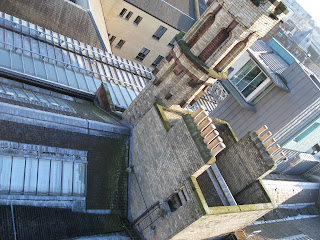The E H Gombrich book 'The History of Art' opens with the quote "There is no such thing as art. There are only artists."
Thursday, 31 January 2013
E H Gombrich
The E H Gombrich book 'The History of Art' opens with the quote "There is no such thing as art. There are only artists."
Sunday, 27 January 2013
Art and blobs
the advent of 3D printers elevates the possible shapes that can easily be manufactured. This has the potential to combine with the growing taste for organic architecture, the work of such architects and designers such as Future Systems [now sadly defunct], Asymptote, Ross Lovegrove etc. We have traditionally relied on rigid cartesian straight lines and right angles, because they are easiest to manufacture and to work with. As soon as you introduce a non-level surface or an angle other than 90 degrees any work rapidly becomes incredibly difficult. Not only do you need to custom fit every piece of material, it is no longer as simple as running a plane over a piece of wood to take a mil off of it.
This taste for straight lines and right angles is not born out of any innate compatibility with human kind. We are not inherently straight or right angled, our reach does not extent across the full limit of a rectangular desk. Where space and ergonomics are of pressing concern, for example in aeroplane cockpits or car interiors, things are moulded and crafted, curved and tactile. Our furniture is starting to become more akin to the seats in cars. And why should it not. What is so different about sitting in a car, from sitting on a sofa.
We are perhaps on the point of tipping over from a world of straight lines and right angles, where a material can easily cover a regular shape, to a world where furniture is shaped into organic blobs made from material that slowly evaporates, or degrades, the way the fresh aluminium will automatically anodise in air. A world where furniture melds into building into function into lifestyle. Where we are surrounded by multifunctional surfaces, kitchen worktops that can equally be screens or heating elements or lights, changing colour with a couple of gestures. A world where you can sit on anything, or pinch and pull to make it into a hard working surface.
Sunday, 20 January 2013
in praise of iteration
I was listening to a podcast about urban planning, and one of the urban planners working with Jan Gehl spoke about their approach of
envision
test
refine
or an iterative test and trial type approach, rather than one that is driven by a masterplan. Personally I always feel that I have to be apologetic about adopting an iterative approach to things, making a start, tweaking a bit, doing a bit more, seeing how it is working. I always feel that I should be arriving with a perfect vision, then simply the dull labour of transforming transcendant vision into actuality.
But an iterative approach has had a bad press. It is far more responsive and democratic. You are not going to go terribly far wrong with an iterative approach, you are not consulting on some masterplan that few can understand, you are seeking views on something as it unfolds, the omissions and improvements can be addressed. Just as we should design for adaptability, so we should plan for iteration.
Project planning is too inflexible, demanding that we set out conforming to the initial materplan, rather than allowing us to evolve a solution that works.
Returning to the initial example, these Danes plan their pedestrian zones a street at a time, relying on a bucket of paint, and seeing what works. Can anyone honestly believe that some huge masterplan would offer a better solution.
Subscribe to:
Posts (Atom)



